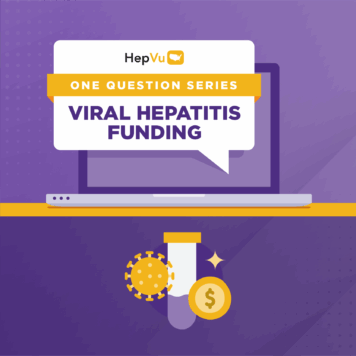Thaddeus Pham is the Viral Hepatitis Prevention Coordinator for the Hawaiʻi Department of Health’s Harm Reduction Services Branch as well as the co-Founder and co-Director of the Hep Free Hawaii Coalition.
Q: You have been the Viral Hepatitis Prevention Coordinator for the Hawaiʻi State Department of Health in the Harm Reduction Services Branch since 2011. A lot has changed in public health and in the world of viral hepatitis during that time including the rise of the opioid epidemic and COVID-19. How have you seen your work change over time?
That’s a big question. Much like other folks working in public health at the time of the COVID-19 pandemic, we saw what other folks saw, which was a shift to address that ongoing pandemic. But that also led to a shift away from needed public health priorities like viral hepatitis. We saw decreases in testing, we saw decreases in vaccinations, and we heard about increases in substance use as people were coping. We were concerned about what that would look like later in terms of infections and spread of hepatitis. Optimistically, during that time, and as we are doing now, we became adept at working virtually. That also expanded the opportunity for our community partners to engage with us more meaningfully. Now, we host several Zoom meetings a month with our coalition members on different topics. That includes folks on the continent, folks in other countries, and folks on our neighbor islands and in our rural communities. So, we certainly gained some great things out of it as well. Our local coalition is definitely more connected because of it.
Q: According to your new report on Hepatitis B mortality, Hawaiʻi has one of the highest Hepatitis B–associated death rates in the U.S. What accounts for this and what concrete steps can lawmakers, advocates, providers, and the general public take to change this?
In the same report, we also looked at liver cancer mortality, and what we found was that there were higher rates of both Hepatitis B-associated mortality and liver cancer-associated mortality in Hawaiʻi compared to the U.S. over a 20–year period. We saw disparate rates when we looked at Asian and Pacific Islander residents, including Native Hawaiian people, compared to all other residents in Hawaiʻi. We can’t say what caused it, but we can make some educated guesses. Our guess is that there is a higher chronicity of Hepatitis B among people who are born in Asia and the Pacific, many of whom come to Hawaiʻi. In Hawaiʻi, almost one out of five people were born in another country. Hawaiʻi is beautifully diverse, and we want to make sure that we take care of our communities.
This information is critical to know because we can use it to save lives. If we provide people screening as recommended by the CDC – universally for Hepatitis B – followed by Hepatitis B vaccines as appropriate and Hepatitis B treatment as recommended, then we can make save lives both in Hawaiʻi and across the U.S. It almost sounds too simple, but it’s quite challenging to even get people screened, vaccinated and treated. There’s a lot of work to do, but at least we know what needs to be done.
It’s also relevant to view this through an HIV/AIDS lens as well. I think the reason we’re able to make great successes through great data is through the visualization of that data. With our mortality report, I think people were able to get it out there because we created a one-page version with just three highlighted themes, and that made it more accessible and digestible. Again, that goes to show the idea of what the community wants versus what we want to give them. That’s why we’re so grateful for HepVu and AIDSVu – these sites make the data accessible in a way that we can bring to policymakers. They don’t have to read too much, but they can see the impact very quickly. It’s so crucial to consider the impact of data, even simple data, and visualization can truly help advance efforts to eliminate Hepatitis B.
Q: Asian Americans, Native Hawaiians, and Pacific Islanders have a high burden of Hepatitis B, yet there is still considerable stigma in these communities around Hepatitis B. What is being done to change that?
The first thing is always just going to the community and seeing if there’s a champion, because really, we want to know from the community themselves what they’re hearing, what they’re thinking, and what their own solutions might be. For example, in our Micronesian community, especially our Marshallese and Chuukese communities, we had a storyteller who was living with Hepatitis B who had to go through a liver transplant and was willing to share his story. His name is Kenson, and he’s now a huge champion and educator – he goes out in his community and provides education and support in nonclinical settings, in places like parks and sporting events where the community congregates. That was only successful because he told us the most culturally congruent way of doing it and was willing to do the work. We were also able to write a grant to help him get paid for it. We want to make sure we always compensate people for their time appropriately. This is just one way – starting with the community, seeing what their solutions are and how we can make it happen for them.
Q: Hep Free Hawaiʻi focuses heavily on letting individuals with lived experience share their stories. Why did you decide to include this in your mission?
Hepatitis B, especially when speaking about chronic Hepatitis B and mortality, really does impact a lot of people who were born in Asia, the Pacific, and Africa, and many might not speak English as their first language. Storytelling is an important way of sharing information in a culturally congruent way. For example, when we first started working in the Asian and Pacific Islander communities around Hepatitis B, we were trying to work with folks and asking them about what materials we should make, or what pamphlets they would like. And they said, ‘You know what? We don’t want any more pamphlets. We just throw them away. Some of us are not even able to read it in our own language. The way we learn is through convening and communing with each other and sharing stories through conversation.’ Anything more story-based where it feels like someone is sharing a story will be perceived much better than just a handout, even if itʻs in their language. So, storytelling is truly a culturally congruent way of addressing the needs of folks when they’re asking questions about viral hepatitis.
Q: It is Asian and Pacific Islander Heritage Month as well as Hepatitis Awareness Month; what message would you have for people impacted by viral hepatitis this month?
I would love to remind people impacted by viral hepatitis that they have more power than maybe they recognize. They should own that power and use it to share their story or reach out for help, because there are people willing to help. I’m willing to help – if folks want to reach out to me, please feel free!
These awareness days and months are helpful in terms of gathering community and garnering attention. Of course, we work throughout the year, but these opportunities really give us a flashpoint to start and motivate folks to keep going. May 19th is Hepatitis Testing Day. It’s also National Asian and Pacific Islander HIV/AIDS Awareness Day. We’re planning to release another story featuring a local man named Robert, where he shares his experience with getting cured of Hepatitis C. It just gives us another chance to uplift and highlight how important it is to eliminate hepatitis, while simultaneously reminding people of how it continues to affect folks locally and in other states and countries as well.




